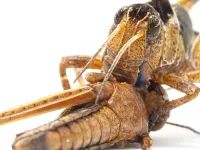(Press-News.org) New York (May 4, 2023) — Today, the American Geriatrics Society (AGS) released the 2023 update to the AGS Beers Criteria® for Potentially Inappropriate Medication Use in Older Adults (DOI: 10.1111/jgs.18372). The AGS Beers Criteria® serves as a comprehensive list of medications that older people should potentially avoid or consider using with caution because they often present unnecessary risks for this population. Given that, according to the National Center for Health Statistics, United States (NCHSUS), more than 88% of older people use at least one prescription and more than 66% use three or more in any given month, the AGS Beers Criteria® are an important clinical, educational, c and quality assurance tool for clinicians across disciplines and the healthcare system as a whole.
“Medications have a vital role to play in helping us to remain healthy, active, and engaged in our communities,” said Donna M. Fick, PhD, GCNS-BC, FGSA, FAAN, AGSF, AGS President-elect and a member of the AGS Beers Criteria® Expert Panel. “The 2023 AGS Beers Criteria® is based on the best available evidence and supports person-centered decision-making that takes into account what matters to an older person, considers both drug and non-drug approaches to care, and is focused on maximizing health while minimizing unnecessary risk.”
Though not an exhaustive catalogue of inappropriate treatments, the five lists included in the AGS Beers Criteria® describe particular medications where the best available evidence suggests they should be:
Avoided by most older adults (outside of hospice and palliative care settings);
Avoided by older adults with specific health conditions;
Used with caution because of the potential for harmful side effects; or
Avoided in combination with other treatments because of the risk for harmful “drug-drug” interactions; or
Dosed differently or avoided among older adults with reduced kidney function, which impacts how the body processes medicine.
First developed by the late Mark Beers, MD, and colleagues in 1991, the AGS took over maintenance and updating of the AGS Beers Criteria® in 2011. For the 2023 update, an expert panel reviewed more than 1,500 clinical trials and research studies published between 2017 and 2022. The resulting 2023 AGS Beers Criteria® include:
Over three dozen individual medications or medication classes to avoid for most older people.
40+ medications or medication classes to use with caution or avoid when someone lives with certain diseases or conditions.
The expert panel also moved several medications to different categories or revised guidance based on new evidence. To simplify and increase usability of the five lists comprising the criteria, the panel moved a number of medications to a separate list given that they have low usage or are no longer available in the United States. The panel still considers these medications as being potentially inappropriate for use in older adults in alignment with the 2019 criteria.
“The AGS Beers Criteria® offers guidance about potentially harmful treatments for all of us as we age, supporting clinicians, patients, and caregivers to choose the safest, most effective treatment when making decisions that are individualized to what matters to the person. Our goal is to improve drug therapy and outcomes by identifying and reducing the prescribing of potentially inappropriate medications in older adults,” noted Todd Semla, MS, PharmD, BCGP, FCCP, AGSF, a co-chair of the 2023 AGS Beers Criteria® expert panel. “The AGS Beers Criteria® should never solely dictate how medications are prescribed or be used to justify restricting health coverage,” he added. “We encourage older adults who see one of their drugs listed on the AGS Beers Criteria to speak with their clinician about an alternative."
Published in its entirety in the Journal of the American Geriatrics Society (DOI: 10.1111/jgs.18372) the AGS Beers Criteria® is also available as a mobile app and as a pocket reference card. Both are designed to meet the needs of busy clinicians practicing in a variety of settings and are available from GeriatricsCareOnline.org. The AGS is committed to bringing the expertise of geriatrics health professionals to the public and lay versions of the Beers Criteria® as well as tools to aid older adults and caregivers in understanding what medications are potentially inappropriate are available for free from https://www.healthinaging.org/HealthinAging.org).
###
About the American Geriatrics Society
Founded in 1942, the American Geriatrics Society (AGS) is a nationwide, not-for-profit society of geriatrics healthcare professionals dedicated to improving the health, independence, and quality of life of older people. Our 6,000+ members include geriatricians, geriatrics nurse practitioners, social workers, family practitioners, physician assistants, pharmacists, and internists who are pioneers in advanced illness care for older individuals, with a focus on championing interprofessional teams, eliciting personal care goals, and treating older people as whole persons. AGS believes in a just society, one where we all are supported by and able to contribute to communities where ageism, ableism, classism, homophobia, racism, sexism, xenophobia, and other forms of bias and discrimination no longer impact healthcare access, quality, and outcomes for older adults and their caregivers. AGS advocates for policies and programs that support the health, independence, and quality of life of all of us as we age. AGS works across patient care, research, professional and public education, and public policy to improve the health, independence, and quality of life of all older people. For more information, visit AmericanGeriatrics.org.
About the Health in Aging Foundation
The Health in Aging Foundation is a national non-profit established in 1999 by the American Geriatrics Society to bring the knowledge and expertise of geriatrics healthcare professionals to the public. We are committed to ensuring that people are empowered to advocate for high-quality care by providing them with trustworthy information and reliable resources. Last year, we reached nearly one million people with our resources through HealthinAging.org. We also help nurture current and future geriatrics leaders by supporting opportunities to attend educational events and increase exposure to principles of excellence on caring for older adults. For more information or to support the Foundation's work, visit HealthinAgingFoundation.org.
About the AGS Annual Scientific Meeting
The AGS Annual Scientific Meeting is the premier educational event in geriatrics, providing the latest information on clinical care, research on aging, and innovative models of care delivery. More than 2,500 nurses, pharmacists, physicians, physician assistants, social workers, long-term care and managed care providers, healthcare administrators, and others will convene in Long Beach, CA, May 4-6, 2023 (pre-conference program on May 3), to advance geriatrics knowledge and skills through state-of-the-art educational sessions and research presentations. For more information, visit https://meeting.americangeriatrics.org/.
END
Many older adults take multiple medications; an updated AGS Beers Criteria® will help ensure they are appropriate
2023-05-04
ELSE PRESS RELEASES FROM THIS DATE:
Study presents new clues about the rise of earth’s continents
2023-05-04
Continents are part of what makes Earth uniquely habitable for life among the planets of the solar system, yet surprisingly little is understood about what gave rise to these huge pieces of the planet’s crust and their special properties. New research from Elizabeth Cottrell, research geologist and curator of rocks at the Smithsonian’s National Museum of Natural History, and lead study author Megan Holycross, formerly a Peter Buck Fellow and National Science Foundation Fellow at the museum and now an assistant professor at Cornell University, deepens the understanding of Earth’s crust by testing ...
Converging ocean currents bring floating life and garbage together
2023-05-04
The North Pacific “Garbage Patch” is home to an abundance of floating sea creatures, as well as the plastic waste it has become famous for, according to a study by Rebecca Helm from Georgetown University, US, and colleagues, publishing April 27th in the open access journal PLOS Biology.
There are five main oceanic gyres — vortexes of water where multiple ocean currents meet — of which the North Pacific Subtropical Gyre (NPSG) is the largest. It is also known as the North Pacific “Garbage Patch”, because converging ocean currents have concentrated large amounts ...
Gutless marine worms on a Mediterranean diet: Animals can synthesize phytosterols
2023-05-04
Cholesterol and phytosterol are sterols, fatty compounds essential for many biological processes such as the functioning of cell membranes. Up to now, it has been assumed that phytosterols are characteristic for plants, and cholesterol for animals, and that only plants can make phytosterols, while animals typically make cholesterol. Dolma Michellod, Nicole Dubilier and Manuel Liebeke from the Max Planck Institute for Marine Microbiology in Bremen, Germany, were therefore surprised when they discovered that a small marine worm called Olavius ...
Scientists begin to unravel global role of atmospheric dust in nourishing oceans
2023-05-04
CORVALLIS, Ore. – New research led by an Oregon State University scientist begins to unravel the role dust plays in nourishing global ocean ecosystems while helping regulate atmospheric carbon dioxide levels.
Researchers have long known that phytoplankton – plantlike organisms that live in the upper part of the ocean and are the foundation of the marine food web – rely on dust from land-based sources for key nutrients. But the extent and magnitude of the impact of the dust – ...
Chemical signal protects migratory locusts from cannibalism
2023-05-04
Huge swarms of migratory locusts take on the proportions of natural disasters and threaten the food supply of millions of people, especially in Africa and Asia. As the eighth of the ten biblical plagues, the Book of Moses in the Old Testament already describes how swarms of locusts darkened the sky and ate up everything that grew in the fields and on the trees. Scientists suspect that cannibalism among locusts contributes to their swarming behavior, and swarms therefore constantly move ...
Pheromone deters swarming migratory locusts from cannibalism
2023-05-04
Swarming migratory locusts – which threaten food security across the globe – avoid being eaten by other locusts by producing a smelly pheromone called phenylacetonitrile (PAN), according to a new study. The discovery of an anticannibalistic signaling pathway in locusts could provide a target for locust management strategies since cannibalistic interactions among locusts have been implicated in creation of swarms, which are highly destructive. A wide range of species practice cannibalism, mostly to supplement nutrition. This has led to the evolution of ...
Social-belonging intervention promotes college success, increasing proportion of students who complete first year
2023-05-04
A randomized controlled experiment featuring more than 26,000 students across 22 4-year U.S. universities shows that the effects of a low-cost, brief online intervention focused on social belonging can promote success and equity for college students. This finding was particularly apparent among those from groups that have historically achieved at lower rates. The likelihood of earning a university degree in the U.S. is highly unequal across racial-ethnic and socioeconomic groups. In most cases, programs designed to help, by promoting college persistence, work differently for different people. Understanding these heterogenous effects ...
Recycled gas feeds a massive galaxy in the early Universe
2023-05-04
Streams of intergalactic gas, enriched with elements heavier than helium, encircle and spiral into a massive galaxy observed at redshift 2.3, researchers report. The findings provide evidence of enriched gas recycling during galaxy formation in the early Universe. Galaxies form through the accretion of gas from the circumgalactic medium (CGM) and intergalactic medium (IGM), which subsequently condenses into stars. Simulations and observations have shown that cold stream accretion – the accumulation of pristine intergalactic gas that contains almost no elements heavier ...
Reconstructing Pleistocene bacterial metabolites to revive their natural products
2023-05-04
Reconstructing the bacterial genomes recovered from the calcified plaque of human and Neanderthal remains has offered new insights into previously undescribed Pleistocene bacterial metabolites, researchers report. The approach expands researchers ability to study microbial natural products, which has otherwise been mostly limited to studying living bacteria. Bioactive small molecules produced by microbes, often called natural products, have been an important source of diverse functional compounds for industry and medicine, including many antimicrobials. Characterizing the natural products encoded in biosynthetic gene clusters ...
CRISPR and single-cell sequencing pinpoint causal genetic variants for traits and diseases
2023-05-04
A major challenge in human genetics is understanding which parts of the genome drive specific traits or contribute to disease risk. This challenge is even greater for genetic variants found in the 98% of the genome that does not encode proteins.
A new approach developed by researchers at New York University and the New York Genome Center combines genetic association studies, gene editing, and single-cell sequencing to address these challenges and discover causal variants and genetic mechanisms for ...







